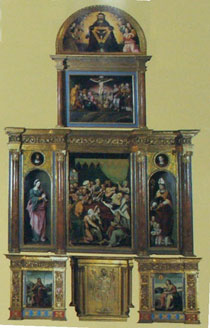Monastery of Tulebras
Main altarpiece
A work of special interest is the main altarpiece of the church, dating from the end of the 16th century and of Mannerist design, which is currently dismantled. As a complement to the important reform that was being carried out in that century, the Aragonese painter Jerónimo Vicente Vallejo Cosida, artistic advisor to Archbishop Don Hernando de Aragón both in the works he promoted in Aragón and in those of this monastery, was commissioned to carry out the work. The altarpiece consisted of a bench formed by pilasters with grotesques and a single body with columns with smooth shafts and composite capitals, crowned with a sober rectangular top.
The Mannerist style paintings, both in terms of the composition and attitudes of the figures, are the work of the aforementioned Jerónimo Vallejo Cosida, and are among his best works.
They have beautiful, somewhat idealised faces, although there is a predominance of well-characterised figures with a certain amount of drama. In general, their hands are fine and elongated. The very elegant outlines come from Italy, with echoes of Raphael and echoes of Leonardo, although there are also some clearly Flemish-inspired group , such as that of the fainting Virgin of Calvary in the attic.
GARCÍA M. COLOMBAS, M.B., Monasterio de Tulebras, Gobierno de Navarra, department de Educación y Cultura, Institución Principe de Viana, Pamplona, 1987.
ORBE Y SIVATTE, A., Monasterio de Tulebras. Un oasis para la contemplación, nº 60, Edilesa, 2001.
REAU, Louis, Iconographie de L'Art Crrétien. (5 vols.), vol. 1, Paris 1956, p. 22.
RECONDO, J.M., "Monasterio de Tulebras", TCP, nº 127, Pamplona, Diputación Foral de Navarra, 1972.
TARIFA CASTILLA, M.J., La arquitectura religiosa del siglo XVI en la merindad de Tudela, Gobierno de Navarra, department de Educación y Cultura, Institución Príncipe de Viana, Pamplona, 2005.












